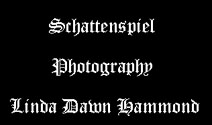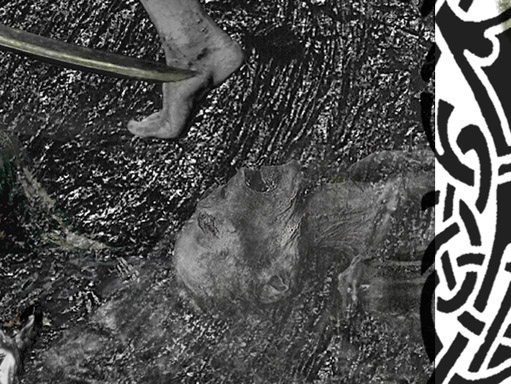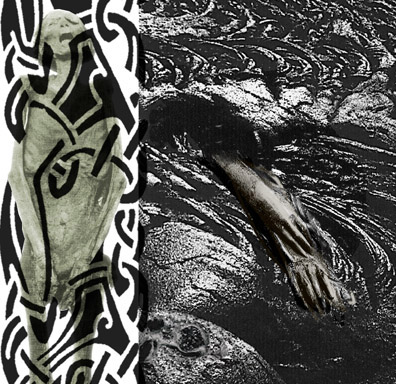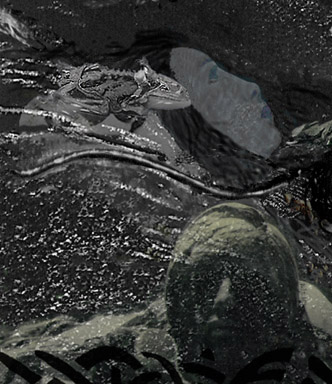

Death/ Schattenspiel Tarot
©Linda Dawn Hammond
1996/2003

Death/ Schattenspiel Tarot
Meanings and Details
XIII DEATH
Death symbolizes the end of a cycle. It need not represent a physical death, and as such is a misunderstood card. Death can be viewed in a positive light, as the clearing away of something no longer valid or of use, such as old attitudes or habits, in order to assist progression.
The reaper of Death in medieval representations was often a female figure, as indicated upon closer examination of its skeletal form. In earlier times, man's role in procreation was largely unknown and the mystery of life remained for centuries an exclusively female domain. Many people in contemporary Western society now assume Death to be of the male gender, however. Perhaps an unwillingness to accept our own mortality has resulted in Death being seen as the violent uprooting of life rather than its natural conclusion. War, domestic violence and popular culture reinforce this vision of death as being visited upon us in the male form. Women are delegated the alternating roles of nurturer / seductress, and the entry of death into the equation would prove unsettling for the majority. That is, unless it was redefined. In other cultures, a connection is made instead which recognizes the creative aspect of woman in the process of life. From woman emerges life, and in taking it away, a cycle is completed. Hence the case for the female representation of Death, which provides the comfort level of the known. I believe that we have also misinterpreted the role of the scythe. In an agrarian society, it reaped the harvest once it had completed its life cycle, which allowed the community to thrive. Rather than a tool, we now see a weapon, so far have we strayed from our natural roots.
In my series, Death is an androgynous figure, chosen for his ability to embody both genders rather than preference one. He is coated in clay, which reminds us that physical death returns one to the earth. The clay is flaking off his skin, and this "shedding" recalls the snake, a goddess symbol, the significance of which is rebirth. In our phallocentric world, the original meaning of the snake symbol has been appropriated, which in turn blurs our understanding of history. Recognizing the snake to be a female symbol assists in the reinterpretation of old myths. For example, when the priests allegedly, "drove the snakes out of Ireland". It was, conceivably, pagan goddess worship they were expelling to make room for their Christian god.

Death is wielding a scythe over several figures partly inbedded in the ground, and his position is that of one engaged in a dance. La Danse Macabre has its origin in Europe during the plague. As a child in Kent, England, it was in unconscious echo of the plague that I danced with my classmates in our self-described "fairy circle", chanting the words, "Ring a round a rosy, a pocket full of posy, a husha a husha we all fall down..." We were oblivious to what the ancient words or our action of falling in a collective heap actually referred to. This image of death is thus derived from my continued fascination with the Plague. It was inspired by Hermann Hesse's novel, Narziss and Goldmund (see dream 1, "The Three Golden Gods"), Albert Camus',La Peste, and Ingmar Bergman's great film, The Seventh Seal.
The man chosen to portray DEATH is involved in the Gothic punk scene and as such, embodied the required mood. On an emotional level, he was facing the immanent death of his own father, who was terminally ill. DEATH had been my lover, but in spite of the recent rupture we decided to continue with the project as planned. This photographic collaboration came to symbolize the end of a cycle in which we danced as one. Death for me contained elements of the seductor- that which is known and desired and ultimately lost.

In the border one sees the remains of an Egyptian mummy who appears to be in the throes of a death agony. He had been evidently buried alive and wrapped in the skin of an unclean animal, for a fatal transgression now lost to us. In my image this figure also appears beneath the scythe of Death, layered within layers of lava, choking.
The scythe has borrowed from a coven which claimed its origins to be the East Coast of the United States. It has been used in rituals. The mice and arms emerging from (or being drawn back) beneath the lava, strangely enough adorn a bronze statue of Peter Pan, located in a children's playground. Peter Pan- the boy who defied death by refusing to grow up. The skeleton of a large frog was discovered in the cellar beneath my loft, which was formerly a coffin factory in Toronto. He is squatting beside a "frog princess"- in reference to the fairy tales of my childhood, which served as my initiation into the notions of romantic love... The frog also figured in the thesis installation. The face in the left foreground is a photograph of a sculpture, located at the base of a street light in the Lower East Side of New York. An unknown artist created street artworks throughout the village and Lower East Side in the late 80s- I tracked them with my camera- the further East they went, the less overtly political, more horrifically, humanly 3 dimensional they became. Another of these sculptures appears as the groin of Pan (my interpretation of The Devil card).

The landscape is of a lava field I photographed on the Island of Hawaii in '77. It represents life- which flows hot, then solidifies, a static memory of what once was. All which passes through will leave its trace, brittle and sharp, to be found or forgotten, seen or overlooked. I remember documenting the lava flows and myself within it. I experienced an exhilarating pain and simultaneous joy at what I believed to be an acute perception of life, embraced within the intensity of the moment. I was quite young. The older I become, the more muted these flights of joy.
Text and photography: Linda Dawn Hammond
NOTE: All images and text on this site are protected under International copyright laws.
Linda Dawn Hammond, 2003. The images posted on this site
are of lower resolution than the originals.
Inquiries regarding current and future exhibitions and purchase orders of this series and others can be made at the following Email Address:
TO
Schattenspiel TAROT CARDS
OR... Visit the
TAROT INSTALLATION